
Transcription
https://www.nlg.org/nlg-review/article/let-lucasville-uprising-prisoners-tell-their-own-stories/
NLG Review
Back to nlg.org | NLGR Submission Guidelines | Guild Notes
Let Lucasville Uprising Prisoners Tell Their Own Stories!
Staughton & Alice Lynd
Staughton and Alice Lynd are prominent activists and have been involved in numerous causes, including the civil rights movement, the anti-war movement, workers’ rights, and prisoners’ rights. They have worked with the ACLU of Ohio as volunteer attorneys for over 20 years.
Introduction
The eleven-day rebellion at the Southern Ohio Correctional Facility (SOCF) in Lucasville, Ohio, began on April 11 and ended on April 21, 1993. Extensive prosecutions followed the negotiated surrender. According to the authorities, there were fifty trials in ten counties, forty-seven guilty findings or guilty pleas, two not-guilty findings, and one hung jury.1
Five prisoners were sentenced to death: Siddique Abdullah Hasan, Keith LaMar, Jason Robb, George Skatzes, and James Were. Their cases are still being litigated. All except Skatzes are held, not on Death Row at the Chillicothe Correctional Institution, but in the highest level of security at the supermaximum security prison, the Ohio State Penitentiary (OSP) in Youngstown.
A second, larger group of participants in the Lucasville events, while not sentenced to death, are in various Ohio prisons, serving what may amount to a lifetime behind bars for offenses such as assaulting or kidnapping a correctional officer.
There has been only limited media attention to the experience of prisoners who took part in the Lucasville uprising compared, say, to their counterparts in the rebellion at Attica, New York in 1971. Some of the reasons for this disparity appear to be:
The events at Lucasville took place at the same time as the siege and occupation of the Branch Davidian compound in Texas, which dominated headlines even in Ohio.
Ten men—nine prisoners and one correctional officer—were killed at Lucasville, while more than forty were killed at Attica.
All the deaths at Lucasville were caused by prisoners. All the deaths at Attica that occurred during the retaking of D Yard by security forces were caused by bullet wounds, and only the forces of the state had guns.
The responsibility of the authorities for the Attica fatalities came to light only after officials up to and including Governor Nelson Rockefeller had initially blamed the deaths of hostage officers on the prisoners. This discovery caused enormous controversy, in which the state government was on the defensive.
But this assessment leaves out one other major difference between the two prison rebellions. At Attica, state prison director Russell Oswald “agreed to the prisoners’ request that the media be allowed into [the occupied] D Yard so that the world could hear what they were trying to accomplish in this protest.” When he returned to D Yard the first evening for a second round of negotiations, Oswald was accompanied by “two newsmen from The New York Times and the Buffalo Evening News, as well as a handful of local reporters. This group was then joined by some national broadcast and print reporters— from NBC, UPI, and ABC.” From that moment on, writes Heather Ann Thompson, “Attica entered history. For the first time ever, Americans could get an inside look at a prison rebellion and watch it unfold.”2
At Lucasville, by contrast, media access was repeatedly demanded by the prisoners and repeatedly denied by the authorities. Prisoner George Skatzes went out on the yard adjoining the occupied cell block on the first full day of the rebellion and stated through a megaphone that the prisoners had “tried desperately, desperately, desperately to get in contact with the news media.” Skatzes continued: “We have been stopped by this administration. They think they can confine this incident within the walls of this prison, like no other part of the world can hear this.”3 When the authorities cut off electricity to the occupied cell block the prisoners hung sheets out of the windows, on one of which they wrote: “This Administration Is Blocking The Press From Speaking To Us.”
The efforts of the Lucasville authorities to inhibit meaningful communication between the many reporters present at the prison and the insurgent prisoners bordered on the ridiculous.4
In fact, a panel of Ohio media representatives convened by the Ohio governor “found a strong predisposition on the part of state officials, including public information officers, not to release information during the Lucasville emergency even when there was no operational reason not to release it.”5
Not only did the authorities inhibit media contact during the uprising, they rigidly followed the same policy until summer 2017. In their answer to a complaint filed in a lawsuit by a number of prisoners and reporters, the authorities repeatedly admitted
that they and their predecessors have consistently denied all members of the press face-to-face media access to any prisoner convicted of crimes committed during the April 1993 Lucasville riot . . . .6
The Court ruled that face-to-face media access cannot be denied based upon the anticipated content of the interview, nor because of the possible impact on victims or their families. In mid-July 2017, the Ohio Department of Rehabilitation and Correction modified its media policies accordingly.7 This action for the first time opened up access to at least some of the surviving prisoner protagonists by newspaper, radio, and TV reporters.
Below, we have attempted to describe some of the questions that media representatives may wish to ask surviving participants and others well acquainted with the Lucasville events, grouping together questions relating to a similar topic.
Strategies of the prisoners and of the state
What were the prisoners trying to achieve?
Prisoners at Lucasville learned that the warden, Arthur Tate, Jr., had decided that beginning Monday, April 12, 1993, every prisoner at SOCF would be injected with a compound containing phenol to test for tuberculosis. Muslim prisoners believed that phenol was a form of alcohol, forbidden by their religion. A Muslim prisoner, Reginald Williams, testified that “we were going to barricade ourselves in L-6 until we can get someone from Columbus to discuss” alternative means of testing for tuberculosis.8 In October 1985, a brief occupation of the disciplinary cellblock at SOCF in which no one was hurt had successfully aired prisoner complaints.
What was the strategy of the state?
Sergeant Howard Hudson of the Ohio State Highway Patrol, who was a member of the state’s negotiation team during the eleven days and its principal investigator after the surrender, testified that “[t]he basic principle in these situations . . . is to buy time, to maintain a dialogue between the authorities and the hostage taker . . . because the more time that goes on the greater the chances for a peaceful resolution to the situation.”9 To increase pressure on the prisoners, the state cut off water and electricity in the occupied cellblock on April 12.
What effect did Tessa Unwin’s April 14 statement about the negotiations have on the prisoners?
On the morning of Wednesday, April 14, a public information officer named Tessa Unwin met with representatives of the media. The reporters asked Unwin about messages written on sheets that prisoners had hung from windows in the occupied cellblock that threatened to kill a guard. She answered, according to a tape of her remarks: “It’s a standard threat. . . . It’s not a new thing. They’ve been threatening things like this from the beginning.”10 Remarkably, the union of correctional officers at SOCF stated in its own assessment: “When an official DR&C spokesperson publicly discounted the media threats as bluffing, the inmates were almost forced to kill or maim a hostage to maintain or regain their perceived bargaining strength.”11
Prosecutorial misconduct I: Targeting the leaders
Did the authorities conduct an impartial investigation without bias against individuals or groups?
Point No. 2 of the 21-point surrender agreement that brought the Lucasville uprising to an end stated: “Administrative discipline and criminal proceedings will be fairly and impartially administered without bias against individuals or groups.”12
In dialogue with injured prisoners housed in the prison infirmary after the surrender, correctional officers made clear who they wanted to convict. As Emanuel “Buddy” Newell lay recovering from wounds inflicted by the insurgent prisoners, on one occasion he was surrounded by a group including Lieutenant James Root, chief investigator Howard Hudson, and troopers Randy McGough and Cary Sayers. According to Newell, “These officers said, ‘We want Skatzes. We want Lavelle. We want Hasan.’ They also said, ‘We know they were leaders. We want to burn their ass. We want to put them in the electric chair for murdering Officer Vallandingham.’”13
Prisoner Johnny Fryman had a similar experience. During the first minutes of the disturbance he had almost been killed by other prisoners. In the SOCF infirmary two members of the Ohio State Highway Patrol questioned him.
They made it clear they wanted the leaders. They wanted to prosecute Hasan, George Skatzes, Lavelle, Jason Robb, and another Muslim whose name I don’t remember. They had not yet begun their investigation but they knew they wanted those leaders. I joked with them and said, “You basically don’t care what I say as long as it’s against these guys.” They said, “Yeah, that’s it.”14
Having found a leader prepared to turn state’s evidence, did the prosecution deliberately contrive a case against other supposed leaders?
ODRC Director Wilkinson and his colleague Stickrath put it this way:
[T]he key to winning convictions was eroding the loyalty and fear inmates felt toward their gangs. . . . Thirteen months into the investigation, a primary riot provocateur agreed to talk about Officer Vallandingham’s death. . . . His testimony led to death sentences for riot leaders Carlos Sanders [Hasan], Jason Robb, George Skatzes, and James Were.15
The only “riot leader” who fits this description is Anthony Lavelle.
Prosecutorial misconduct II: The role of Anthony Lavelle
What persuaded Lavelle to turn state’s evidence?
The evidence suggests a deliberate scheme of misrepresentation by the prosecution. According to a letter from Skatzes to his counsel, Attorney Jeffry Kelleher, and a letter from Lavelle to Jason Robb that is an exhibit in Robb’s case, what happened was the following:
Hasan, Lavelle, and Skatzes were housed in adjacent single cells in the “North Hole” at Chillicothe Correctional Institution. Skatzes was told he had an attorney visit and left his cell in the company of correctional officers. When he arrived at the designated location for the meeting, he learned that he did not have an attorney visit; instead, the prosecution wanted to try one last time to persuade him to cooperate with them. Skatzes politely said No and turned to return to his cell. The representatives of the prosecution told him that would not be allowed. Skatzes protested, stressing that he would be regarded as a snitch if he did not return. The prosecutors were obdurate. Skatzes was housed elsewhere for the next few days. Meanwhile, Lavelle wrote to Robb:
Jason:
I am forced to write you and relate a few things to you that have happened down here lately.
With much sadness I will give you the raw deal, your brother George has done a vanishing act on us. Last Friday, the OSP [Ohio State Patrol] came down to see him. . . . Now to be short and simple, he failed to return that day and today they came and packed up his property which leads me to one conclusion that he has chosen to be a cop. . . .
Lavelle16
Why did the prosecution not pursue Anthony Lavelle as the prisoner who selected and supervised the prisoners who actually killed Officer Vallandingham?
There is overwhelming evidence that Lavelle, the prisoner the prosecution persuaded to become a witness for the state, was also the person responsible for the death of Officer Robert Vallandingham. It was Lavelle who began to put together a death squad on April 14. It was Lavelle who directed members of the Black Gangster Disciples to kill the officer in the L6 shower on April 15. It was Lavelle who confessed to prisoners Roy Donald and Leroy Elmore that it was he who had directed Vallandingham’s murder, and whom James Were knocked down for implementing this fateful decision without authorization from the prisoners’ decision-making committee.17
But Lavelle could not be the fall guy. The prosecution needed him as their star witness. The fact that the prosecution’s star witness was also the man who planned and directed the killing of Officer Vallandingham led to the fundamental hypocrisy of the Lucasville prosecutions.
From the point of view of the prosecutors, it didn’t matter who the state chose to execute for murdering a guard, as long as they executed somebody.18 Prosecutors used Ohio’s law on complicity,19 holding that anyone present at the scene of a homicide who assists in any way is as guilty as the person who pulls the trigger. They argued that any prisoner who was present at the meeting on the morning of April 15, at which it was decided to kill a hostage correctional officer, deserved the death penalty.
The problem with this theory was that the prisoners at the meeting did not decide to kill anyone. The prosecution relied on a tape recording known as “Tunnel Tape 61.” It does not contain a decision to kill a guard. Rather, the decision was that George Skatzes should get back on the phone and ask for water and electricity to be restored in the occupied cellblock, and that the police were to be removed from the tunnels. If, and only if, the authorities refused these demands would there be further discussion and a decision as to whether to kill a hostage. A second meeting to make that decision would be held in the afternoon.
The prosecutors’ insistence that a guard’s murder had been decided was supported only by oral testimony from the state’s stable of prisoner informants. It required casting Skatzes, who in fact had negotiated a first step toward peaceful settlement, and who alone cautioned the group about the hazards of killing a guard, as a murderer. It required overlooking the fact that Lavelle, disgusted with the alleged cowardice of representatives from the Muslims and the Aryan Brotherhood, had stormed out of the morning meeting and proceeded to mobilize his ad hoc death squad.
Finally, there is the shocking fact that the prosecution concedes that it does not know who did the actual killing. Documentary filmmaker Derrick Jones interviewed Daniel Hogan, who prosecuted Robb and Skatzes and is now a state court judge. Hogan told Jones on tape: “I don’t know that we will ever know who hands-on killed the corrections officer, Vallandingham.”20
Prosecutorial misconduct III: Judicial proceedings
Did the prosecutors violate accepted standards for prosecutorial conduct at all stages of the judicial proceedings?
Grand jury testimony by prosecutors not present at the events described.
The indictments that sought the death penalty for Lucasville insurgents were issued by the prosecution on July 29, 1994. Howard Hudson, chief investigator for the prosecution, testified as follows:
Did any inmate testify before the Scioto County grand jury, sir?
No, sir. There were nine separate grand jury sessions. All testimony at that time was provided in summary form by myself and several of the investigators working the case.21
Thus, the supposed facts relevant to the indictments were selected, written up, and presented to the grand jury solely by Sergeant Howard Hudson and other prosecution investigators who were not present when the alleged events took place.
This is a questionable practice. In 2011 the Ohio Supreme Court created a Joint Task Force to Review the Administration of Ohio’s Death Penalty. The Task Force published its findings in April 2014. Task Force Recommendation No. 38 was: “Require the prosecutor to present to the grand jury available exculpatory evidence of which the prosecutor is aware.” The recommendation was adopted by a Task Force vote of 10–9 but the legislature has not acted on it.
Failure to present to the grand jury witnesses who were present at the events necessary for indictment is not technically unlawful. Rule 101(C) (2) of the Ohio Rules of Evidence provides that “proceedings before grand juries” are not subject to the state’s general rules of evidence, including the prohibition of hearsay. However, recommendation by a representative panel that prosecutors should be required to present to the grand jury exculpatory evidence shows a recognition within the profession of the one-sidedness of current grand jury practice.
Moreover, at trial hearsay prohibitions do indeed apply. In the Lucasville litigation prosecutors repeatedly sought to lay their own interpretations before trial juries in the guise of simply summarizing commonly known facts. Thus, in the first of the trials, in which the defendant Jason Robb was sentenced to death, counsel for the state sought to present “summary testimony” by Howard Hudson. When the questions and answers turned from matters like the layout of the prison to facts concerning what happened, counsel for Robb objected, the objection was sustained, and the witness was instructed “not to give testimony that some other witness can testify to.”22
Discovery
Under the familiar Brady rule, statements relevant to the guilt or innocence of an accused must be made available to his or her counsel.23
Keith LaMar’s constitutional right to a fair trial was violated when the prosecutor withheld transcripts or summaries of interviews with forty-three prisoners who witnessed the homicides for which LaMar was later convicted. Also, the forty-three names did not include the names of five prisoners who subsequently became prosecution witnesses at LaMar’s trial.
Four of the Lucasville capital defendants were charged primarily with complicity in the murder of Officer Vallandingham on April 15. Keith LaMar, however, was charged with involvement in murders on April 11 and April 13. Although the federal court belatedly ordered that LaMar be provided with the same discovery as his four colleagues, that discovery was of no use to him and the prosecution refused to join his counsel in asking the court to order discovery for LaMar relevant to the particular homicides for which he was indicted.24
Prisoner informant testimony
The unreliability of prisoner informant testimony is generally recognized, and very little evidence of any other kind was available in the Lucasville cases. Testimony by prisoner informants, especially informants who receive something of value (such as a letter to the Parole Board, transfer to a lower-security prison, or grant of immunity from charges) in exchange for their testimony, is inherently unreliable. It is particularly unreliable when, as in the Lucasville cases, there was no physical evidence that linked any suspect to any weapon or any suspect to any victim.25 Accordingly, the prosecution resorted to the use of “snitch” testimony.
So-called accomplice testimony was defended by Prosecutor Hogan in the trial of George Skatzes. It is true, he conceded, that the state cut a deal with Anthony Lavelle. Mr. Skatzes had an opportunity to do so and
chose not to take it. Had Mr. Skatzes taken it . . . Mr. Skatzes would be up there on the witness stand testifying and Mr. Lavelle would be sitting over there . . . . [T]he State is going to have to cut deals with people who have seen things, who have done things.26
However, long ago the United States Supreme Court declared that such accomplice testimony “ought to be received with suspicion, and with the very greatest care and caution, and ought not to be passed upon by the jury under the same rules governing other and apparently credible witnesses.”27 Ohio seeks to guard against the perjury of accomplices by requiring the judge to give the following instruction to the jury:
The testimony of an accomplice does not become inadmissible because of his complicity, moral turpitude, or self-interest, but the admitted or claimed complicity of a witness may affect his credibility and make his testimony subject to grave suspicion, and require that it be weighed with great caution.28
The only kind of witness testimony in the Lucasville cases that was clearly objective was that of the medical examiners who gave testimony based on their autopsies. But when the medical examiner testified that there was no evidence that prisoners had placed a weight bar over Officer Vallandingham’s throat, and rocked back and forth on it until the officer was dead, the state nonetheless continued to offer prisoner witnesses who claimed to have seen that very thing.29
In recognition of the unreliability of informant testimony, the House of Delegates of the American Bar Association resolved on February 14, 2005, that the ABA “urges federal, state, local and territorial governments to reduce the risk of convicting the innocent, while increasing the likelihood of convicting the guilty, by assuring that no prosecution should occur based solely on uncorroborated jailhouse informant testimony.”30
Because there was no objective corroborating evidence linking any suspect to any victim during the Lucasville uprising, Ohio should follow the example of the State of New York after Attica, and vacate the indictments of those men who have already served a quarter of a century for their offenses, real or imagined, during the Lucasville events.
Prosecutorial misconduct IV: Perjured testimony
How did perjured testimony affect some individual defendants?
Derek Cannon
Derek Cannon was identified by the authorities as a member of the so-called “death squad” responsible for murdering several supposed snitches during the first afternoon of the uprising. He was convicted of aggravated murder by a Cincinnati court and he was sentenced to life in prison consecutive to any terms already serving.
Mr. Cannon’s record was reviewed in 2005 by Colin Starger, then a staff attorney for the New York City office of the Innocence Project. Since that office offers representation only in cases involving DNA, Starger could not serve Cannon as his lawyer. However, he sent a detailed request for help for Cannon to a number of like-minded organizations.31
Derek Cannon was indicted and convicted for taking part in the murder of a prisoner named Darrell Depina. However, after the defense rested, the prosecution called Dwayne Buckley as a rebuttal witness. Buckley testified that he had been a porter in the jail where Cannon was confined during his trial and that Cannon had confessed not only that he murdered the inmate, but that Cannon also tortured and murdered the hostage officer several days later. This informant was the last witness at Cannon’s trial.
However, Derek Cannon could not have been present in L-block on April 15 when the officer was killed. Contemporaneous records show that Cannon was taken off the recreation yard during the early hours of April 12, and was transferred to the Lebanon Correctional Institution a few days later. What is more, Dwayne Buckley has since recanted his testimony.32
Cannon’s trial counsel Joseph Hale states that the judge, after speaking to jurors, told him that Buckley’s testimony had “impressed a lot of the jury as to what kind of person Cannon was.” Attorney Starger’s memorandum pointed out that no state or federal court, in reviewing the case on appeal, had even mentioned Buckley.
Keith LaMar
Withheld from Keith LaMar was testimony to the effect that it was not LaMar but a prisoner named Stacey Gordon who led and supervised the murderous work of the death squad in L6. In the related case of Timothy Grinnell, prisoners Prentice Jackson and Leroy Elmore testified that prisoner Stacey Gordon entered L6 at the head of the death squad and ordered the prisoners operating the L6 console to open the doors of the cells where prisoners suspected of being snitches were confined.33
Stacey Gordon took a plea agreement on September 8, 1994. On that day, Gordon answered the following questions by Prosecutor Tolbert:
Do you know Keith Lamore?
No. . . .
Did you see Keith Lamore in the L-6 block in the early hours of the riot at Lucasville?
No. . . .34
Yet when LaMar went to trial in the summer of 1995, Stacey Gordon was a leading prosecution witness against him.
George Skatzes and Aaron Jefferson
In December 1995, George Skatzes was found guilty of being the principal offender in the death of prisoner David Sommers. The medical examiner, Dr. Leo Buerger, testified that Sommers had been killed by a single, massive blow to the head, struck by a blunt instrument such as a baseball bat.35 (A bloody baseball bat, found across the corridor from the area where Sommers was murdered, was later destroyed by order of the chief Lucasville prosecutor.)
On March 21, 1996, prisoner Aaron Jefferson, in a separate trial, was found guilty of committing the same murder. Once more, Dr. Buerger testified. Again he insisted that the cause of death was one single massive blow to the head. Asked whether the fatal injury could have been the result of multiple blows, the doctor told the jury that all the skull fractures were the result of “just that one blow.”36
Thus two men were found guilty of striking a single lethal blow. In closing argument in the trial of Skatzes, Prosecutor Hogan asked the jury to think “about David Sommers . . . the one where Skatzes wielded a bat and literally beat the brains out of this man’s head.”37
And in the later trial of Jefferson, Prosecutor Crowe told the jury:
If there was only one blow to the head of David Sommers, the strongest evidence you have [is that] this is the individual. I won’t call him a human—this is the individual that administered that blow. . . . If there was only one blow, he’s the one that gave it. He’s the one that hit him like a steer going through the stockyard, the executioner with the pick axe, trying to put the pick through the brain.38
George Skatzes was sentenced to death, and Aaron Jefferson was sentenced to life in prison, each for administering the one fatal blow that killed David Sommers.
Siddique Abdullah Hasan and James Were
The prosecution faced a challenge in pinning any of the homicides on the Muslim imam, Siddique Abdullah Hasan. A prisoner informer named Roger Snodgrass testified that Hasan had chaired the meeting at which it was allegedly decided to kill a guard.39 But investigator Hudson testified in the first trial of James Were that it was unclear whether Hasan had even been present at that meeting, which had been chaired by another Muslim named Stanley Cummings.40
Yet from the standpoint of the authorities, if they were to use the post-surrender trials to convict the men who the authorities believed to have been the leaders of the uprising, Hasan, who they thought had planned the rebellion, could not be left out. Accordingly, the prosecution deliberately promoted a narrative of Vallandingham’s murder that it knew from the outset to be false.
It happened as follows.41 In an attempt to be released from prison in return for snitching, three prisoners—Kenneth Law, Stacey Gordon, and Sherman Sims—concocted a story that pinned the murder of Officer Vallandingham on two men the three knew that the state wished to convict: Hasan, the current imam, and his predecessor in that role, James Were.
According to this story, a little after 10 a.m. on the morning of April 15, Officer Vallandingham, bound and blindfolded, was brought to the shower room on the lower tier of L6. Hasan told Were that he was leaving L6 and if Were did not receive a phone call from Hasan within the next ten minutes, he was “to take care of his business.” Hasan then left L6. A few minutes later, according to the story, Were instructed two other prisoners to proceed. They supposedly did so, rocking back and forth on a weight bar placed on Vallandingham’s neck to make sure they had killed him.
After jointly creating this false account of Officer Vallandingham’s death, Sims and Law experienced what Law describes in a 2000 affidavit as “a falling out.” Sims changed his original telling of the murder narrative to name Law as one of the hands-on killers.
In the summer of 1995, the authorities put Law on trial for his actions as described by Sims. The jury found Law guilty of kidnapping but deadlocked on the more serious charge of homicide.
The prosecutors still had no solid evidence that Hasan was complicit in the murder of the officer. Accordingly, they confronted Law with the demand that he agree to be a witness against Were and Hasan. In return for Law’s testimony, prosecutors agreed to present to the jury the false narrative Law, Gordon and Sims had originally told the authorities, with no implication that Law himself was guilty of any wrongdoing. The prosecutor would tell the Were and Hasan juries that they should not doubt Law’s testimony because Law was simply repeating the statement he had made to the prosecution together with Gordon and Sims.
With extraordinary candor the prosecutor gave Law the opportunity to witness to the truth, of course at the risk that he would himself be sentenced to death. The question and answer went like this:
[Y]ou’re here today to testify in the case of State of Ohio versus Hasan, is that correct?
Yes.
Now was there an agreement in regards to what you were supposed to testify to?
The truth of the statement that I originally made.
Okay. You made a statement to the State Patrol at some time prior, is that correct?
That is correct.
And you’re supposed to tell us basically what you told us in that statement, is that correct?
That’s the truth.
And what’s to happen if you don’t testify consistently to the statements you’ve already made to the State Patrol?
The original charge can be reinstated with the death specifications.42
The heart of the prosecutors’ problem was that they could not reveal that their critical witness, Anthony Lavelle, was also the man responsible for killing a correctional officer. As Law recounted the events, “At one point, I revealed to them that Anthony Lavelle had killed Vallandingham. The prosecutor told me that my story would have to change, because Lavelle was a State witness.43
Conclusion: Convict race
Why should journalists be interested in this sordid story of self-interest, betrayal of trust, and indiscriminate violence?
Because for a time, prisoners in rebellion overcame the deep-seated racial prejudice with which the Lucasville prison was saturated. Ohio deliberately built its maximum security prison in a rural area where there appear to have been no African-American residents, with the result that 85 percent of the 205 correctional officers at Lucasville were white, whereas the prisoners, drawn from Ohio’s inner cities, were 57 percent African American.44
Two of the slogans painted on the prison walls during the uprising at Lucasville were “Convict Unity” and “Convict Race.”
George Skatzes and Jason Robb were members of the Aryan Brotherhood when the Lucasville uprising took place. African Americans Hasan and Were were also among the representatives that negotiated or made decisions on behalf of the approximately 400 prisoners in L block. Hasan and Were were Sunni Muslims.
These men dealt with racism by seeking to overcome it. Slogans painted on the walls of the occupied cellblock said “Black and white together,” “Whites and blacks together,” “Black and white unity.” Skatzes, finally able to speak to the media on the evening of April 15, declared in a radio address that was carried at least as far north as Mansfield:
We are oppressed people, we have come together as one. We are brothers. . . . We are a unit here. They try to make this a racial issue. It is not a racial issue. Black and white alike have joined hands in SOCF and become one strong unit.45
Jason Robb addressed the issue of race in his unsworn statement to the jury before sentencing. Jason had grown up in predominantly white neighborhoods where he had little contact with blacks, he told the jury. Now he was in a prison community where most prisoners were black. At Lucasville he worked with blacks and, as he did so, “got to talking” with them.
Jason worked as a plumber and got to know a black electrician.
This guy’s showing me how to do electric work and I’m showing him how to do things and basically we’re teaching each other how to do work and he was a pretty militant black guy.” “[I]t surprised me that me and him could talk. . . . And he explained to me his beliefs. . . . And that kind of surprised me that he would be open with me like that. . . . So I explained to him how I felt. And we . . . built a respect between us. . . .”46
One of the many journalists to whom the New York prison system offered access to its embattled prisoners while the Attica uprising was going on was Tom Wicker of The New York Times. Wicker, a Southerner, became deeply involved. After the massacre on the last day of the uprising, he wrote a book about it called A Time to Die. Wicker’s discussion included the following:
Could he be seeing in D-yard, Wicker wondered, that class interest might overcome racial animosities? Was it possible that the dregs of the earth, in a citadel of the damned, somehow in the desperation of human need had cast aside all the ancient and encumbering trappings of racism to find in degradation the humanity they knew at last they shared?47
Another important question is whether what happened at Attica and Lucasville brought about permanent improvements in the lives of the imprisoned. Ms. Thompson concludes that in the immediate aftermath of Attica, the horror of that tragedy “spark[ed] some serious reforms of the American criminal justice system.” Attica also “reflected, and helped to fuel, a historically unprecedented backlash against all efforts to humanize prison conditions in America.” By the early 1990s, Thompson writes, “conditions at Attica were worse than they had ever been.”48
Something similar appears to have happened after Lucasville. At the time of the uprising Ohio had reinstated the death penalty but had not executed anyone again after decades of disuse. In a matter of weeks following the negotiated settlement of the Lucasville upheaval, about 25,000 persons signed a petition calling for the revised statute “to be applied,” and directing that signed petitions were to be returned to Death Penalty, P.O. Box 1761, Portsmouth, Ohio.
A prisoner who was at Lucasville in 1993, and again more recently, reports that
virtually all of the positive changes in conditions at SOCF are the result of changes that have been implemented statewide. . . . Other improvements at SOCF, such as wheelchair-accessible cells, were mandated by the ADA and first implemented at lower-security prisons before finally being constructed at SOCF. . . . The most significant changes at SOCF as a result of the 1993 riot involve security, aimed at providing security for staff at the cost of dehumanizing inmates. . . . The “conditions” of real importance to inmates—recreation, commissary, jobs, vocational schools—have all been reduced or eliminated since the riot. . . . [T]he library . . . is a SMALL fraction of what it used to be, probably 25%, if that much. It’s a disgrace.
Our plea is that we should begin analysis and action with the perceptions of prisoners themselves. If there are institutional barriers that prevent prisoners from sharing their insights and experience with those outside the walls, we must confront and overcome them.
________________________
NOTES
Reginald A. Wilkinson & Thomas J. Stickrath, After the Storm: Anatomy of a Riot’s Aftermath, Corrections Management Quarterly, 1997, at 21. See Transcript of Record at 1139, State v. Law, Case No. B-9409511 (Hamilton Cnty. Ct. of C.P. 1995) (according to the testimony of chief investigator Howard Hudson, as of August 1995, 50 prisoners had been indicted, and there were 37 convictions resulting from 24 plea bargains and 13 trials).
Heather AnnThompson, Blood inthe Water: The Attica PrisonUprisingof 1971 and its Legacy 76-77 (2016).
A D Jones Film, The Great Incarcerator, Part 2: The Shadow of Lucasville, YouTube (June 28, 2017), https://www.youtube.com/watch?v=YqVslMz1UaA [hereinafter The Shadow of Lucasville].
See Bruce Porter, The Lucasville Follies: A Prison Riot Brings Out the Worst in the Press, Columbia JournalismRev., May-June 1994.
Lucasville Media Task Force, Lucasville Media Task Force Report 1 (1994).
Answer at ¶¶ 19, 20, 25, 27, 28, 37, 38, 39, 44, 45, 48, 49, 51, 52, 54, 60, 62, 69, Hanrahan v. Mohr, Case No. 2:13-cv-1212 (S.D. Ohio 2017).
See Ohio Dept. of Rehab. and Corr., Media Policy, No. 01-COM-09 (2017); Ohio Dept. of Rehab. and Corr., Media Policy—Death Row and Executions, No. 01-COM-13 (2017).
Transcript of Record at 2129, State v. Sanders, Case Nos. B-953105 and C-960253 (Hamilton Cnty. Ct. of C.P. 1996) [hereinafter State v. Sanders].
Id. at 2719, 2721.
Transcript of Record at 1045-46, State v. Robb, Case No. 94-CR-10-5658 (Franklin Cnty. Ct. of C.P. 1995) [hereinafter State v. Robb].
Ohio Civil Service Employees Association, Report and Recommendations, AFSCMELocal 11, Aug. 1993, at 71.
StaughtonLynd, Lucasville: The Untold Story of a PrisonUprising65-66 (2d ed. 2011) (as it appears in a copy of the 21-Point Agreement signed by Warden Arthur Tate, Jr. on Apr. 18, 1993).
Id. at 74 (quoting the Affidavit of Emanuel “Buddy” Newell, dated Dec. 30, 1998).
Id. (quoting the Affidavit of John L. Fryman, dated June 17, 1998).
Wilkinson & Stickrath, supra note 1.
State v. Robb, supra note 10, at Def.’s Ex. 8 (excerpted from Anthony Lavelle to Jason Robb on Apr. 7, 1994).
See Lynd, supra note 12, at 47-62.
See The Shadow of Lucasville, supra note 3, at minutes 47:54-48:08 (Daniel Hogan, who prosecuted Jason Robb and George Skatzes, states “[e]ventually you get to the point where you have to decide whether we’re going to do something or we’re going to do nothing. And, in this instance, I think doing nothing was not a choice. Something had to be done.”).
Ohio Rev. Code § 2923.03 (2017).
20 The Shadow of Lucasville, supra note 3, at minutes 42:17-42:25. See also The Shadow of Lucasville, supra note 3, at minutes 34:25-34:27 (Daniel Hogan states, “I don’t know. And I don’t think we’ll ever know.”)
21 Transcript of Record at 650, State v. Jefferson, Case No. 95-CR-3922 (Montgomery Cnty. Ct. of C.P. 1996) [hereinafter State v. Jefferson].
22 State v. Robb, supra note 10, at 405.
23 Brady v. Maryland, 373 U.S. 83 (1963). In Banks v. Dretke, 540 U.S. 668, 695-96 (2004) (The State argued that even when the prosecution had concealed evidence, the prisoner had the burden of discovery so long as the “potential existence” of that evidence might have been detected. The Supreme Court rejected that argument: “A rule thus declaring ‘prosecutor may hide, defendant must seek’ is not tenable in a system constitutionally bound to accord defendants due process.”).
24 See Robb v. Ishee, Case No. 2:02-cv-535 (S.D. Ohio June 26, 2017) (“The Court will not entertain or authorize any request by LaMar’s counsel for any discovery above and beyond whatever counsel for Robb, and/or Were, and/or Hasan choose to share with LaMar’s counsel. Nor will the Court order counsel for Respondent to do anything in the way of furnishing or facilitating any discovery. . . .”).
Transcript of Record at 1913, State v. Skatzes, Case Nos. 94-CR-2890, 94-CR-2891 (Montgomery Cnty. Ct. of C.P. 1996) (referencing the testimony by lead investigator Howard Hudson) [hereinafter State v. Skatzes].
Id. at 5751, 6101.
Crawford v. United States, 212 U.S. 183, 204 (1909).
Ohio Rev. Code § 2923.03(D) (2017).
See Staughton Lynd, Napue Nightmares: Perjured Testimony in Trials Following the 1993 Lucasville, Ohio Prison Uprising, 36 Cap. U. L. Rev. 559, 611-12 (2008) (sources cited therein) [hereinafter Napue Nightmares].
See AmericanBar AssociationCriminal Justice Section, Report to the House of Delegates 8 (2005), available at https://www.americanbar.org/content/dam/aba/publishing/criminal_justice_section_newsletter/crimjust_policy_am05115a.authcheckdam.pdf.
Memorandum from Attorney Colin Starger, N.Y. Innocence Project, “Derek Cannon: A Compelling Non-DNA-Based Innocence Claim” (Dec. 22, 2005) (on file with author).
A Listing of Inmate[s] Recovered from the yard shows Derek Cannon as having been removed from the yard on April 12, 1993, and his name does not appear on any of the lists of prisoners removed from L-block on the night of April 21, 1993. Buckley recanted his entire testimony in 2017. Def.’s Motion for Leave to File a New Trial Motion and Memorandum in Support at Def.’s Ex. A, State v. Cannon, Case No. B-9507633 (Hamilton Cnty. Ct. of C.P. 1995).
See Transcript of Record at 476-78, State v. Grinnell, Case No. 94-CR-11-6418 (Franklin Cnty. Ct. of C.P. 1995) (referencing testimony of Prentice Jackson); see also id. at 521-23 (referencing testimony of Leroy Elmore).
See Transcript of Record, State v. Gordon, Case No. 94-CR-153 (Scioto Cnty. Ct. of C.P. 1994) (quoting from the statement of Stacey Gordon on Sept. 8, 1994. This statement was not produced in discovery before LaMar’s trial and was brought to the attention of LaMar’s counsel years later).
State v. Skatzes, supra note 25, at 3292-95 (referencing testimony by Dr. Leo Buerger).
State v. Jefferson, supra note 21, at 267-68, 275, 283.
State v. Skatzes, supra note 25, at 6108.
State v. Jefferson, supra note 21, at 656-57.
State v. Sanders, supra note 8, at 2513.
Transcript of Record at 1037, 1046, State v. Were, Case No. B-958499 (Hamilton Cnty. Ct. of C.P. 1995).
See Napue Nightmares, supra note 29, at 604-11 (for a detailed, fully-footnoted account of this complex series of events).
State v. Sanders, supra note 8, at 2301-02.
State v. Skatzes, supra note 25, at Post-Conviction Ex. 27 (referencing Affidavit of Kenneth Law at paragraphs 11, 13).
Lynd, supra note 12, at 135 and sources cited therein.
State v. Skatzes, supra note 25, at Ex. 309A. For a fuller discussion of race in the Lucasville uprising, see Lynd, supra note 12, at 133-49.
State v. Robb, supra note 10, at 5486-87.
TomWicker, ATime to Die: The Attica PrisonRevolt (Quadrangle 1975).
Thompson, supra note 2, at 558, 561, 567.
Other posts by this author
|
2023 may 31

|
2023 mar 20

|
2022 aug 23

|
2022 aug 23

|
2022 aug 23

|
2022 aug 23

|
More... |
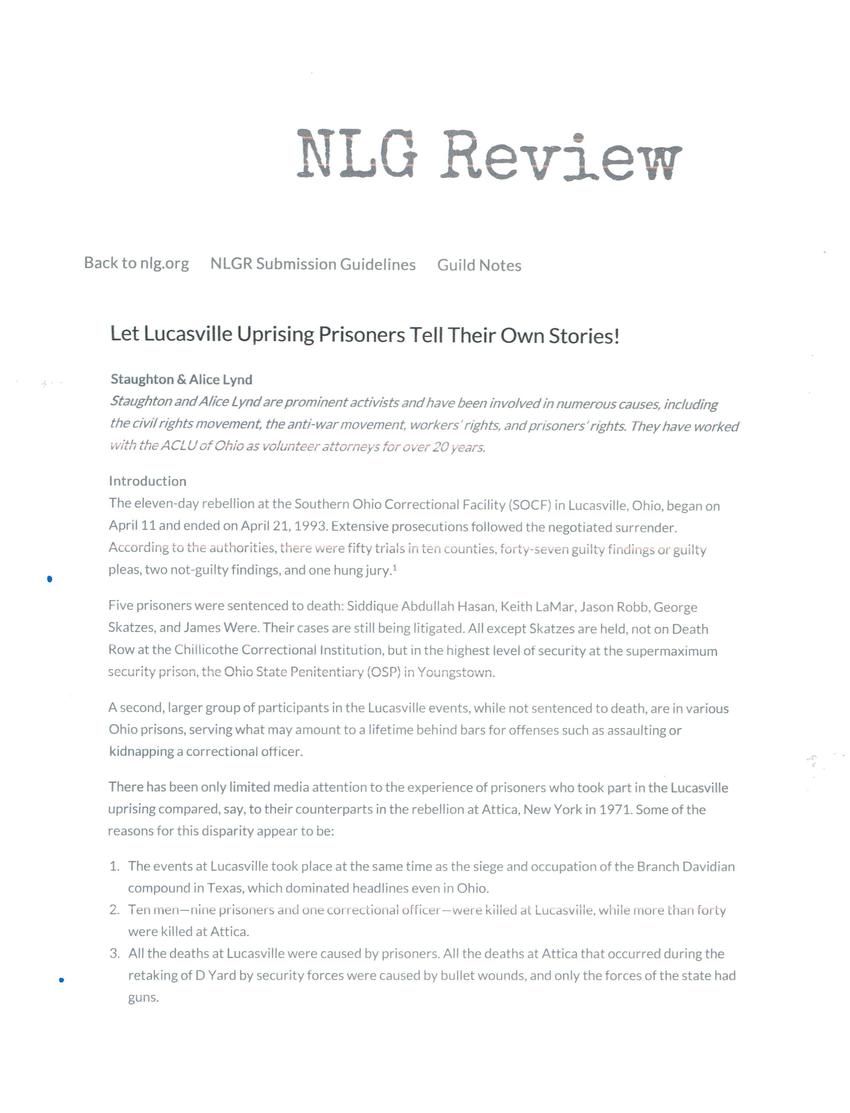
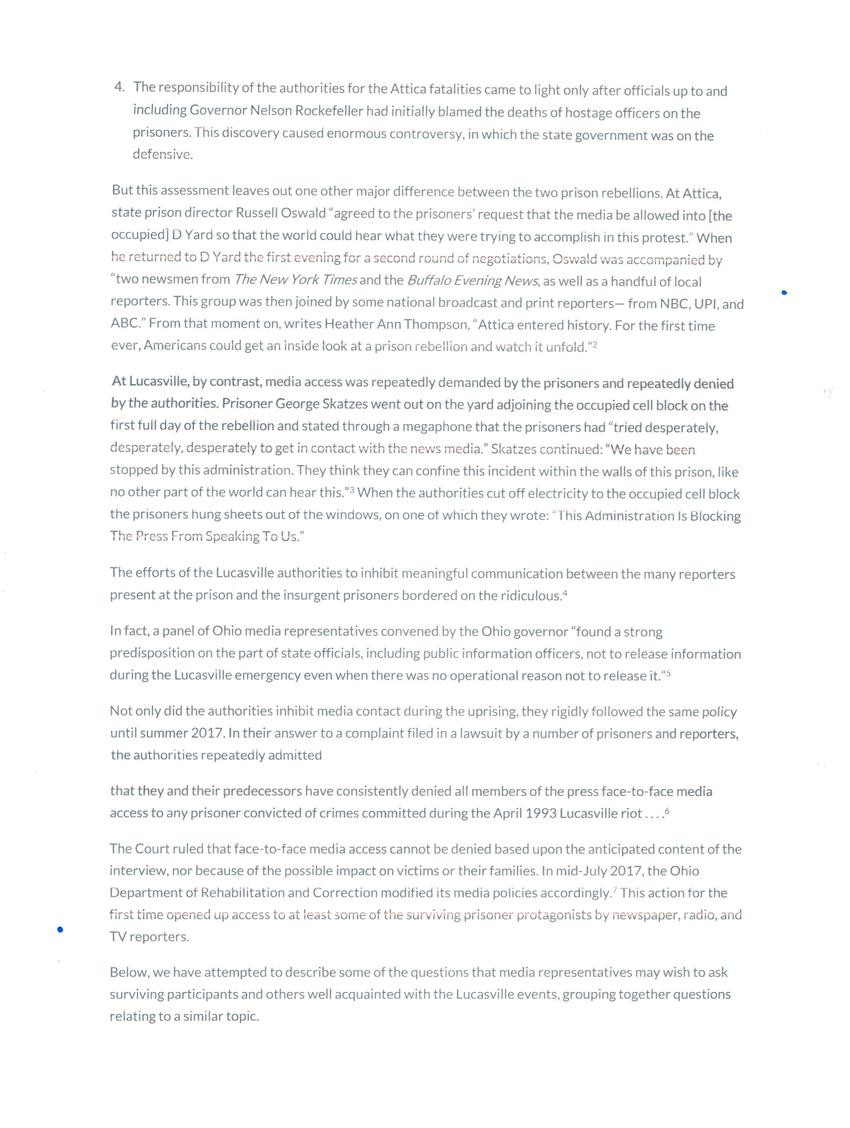
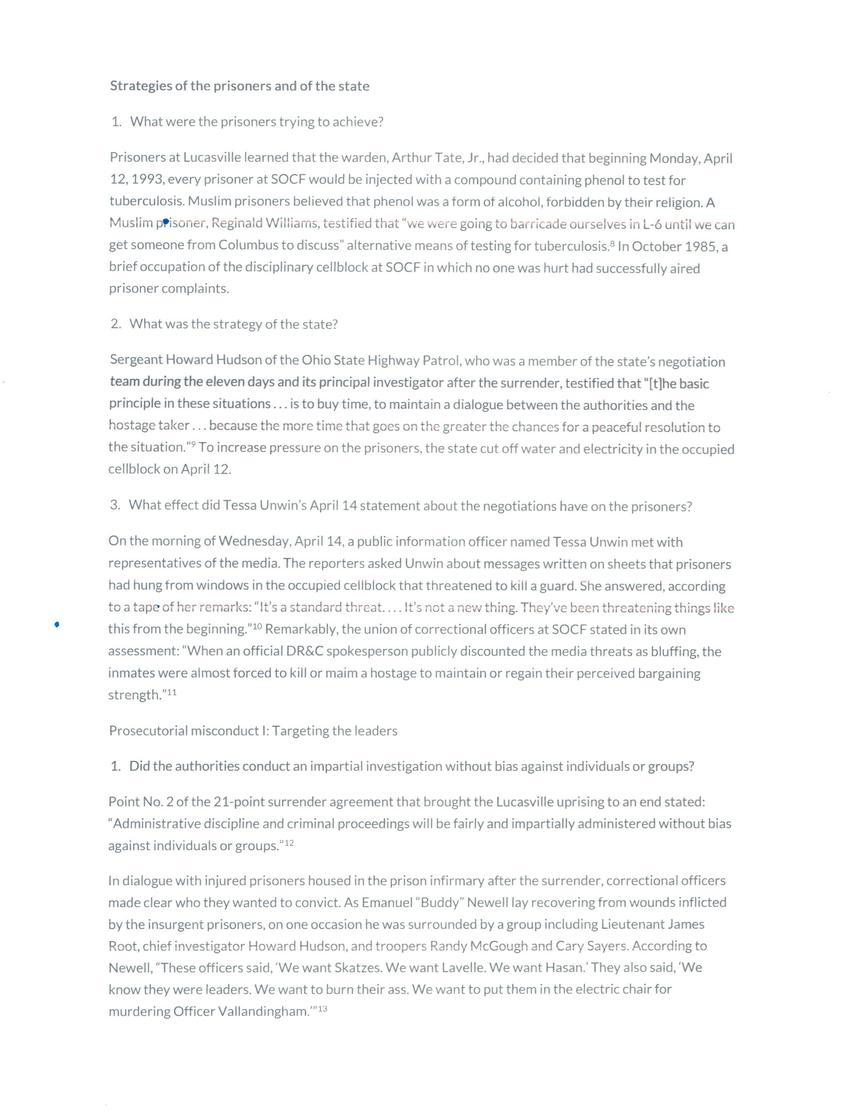
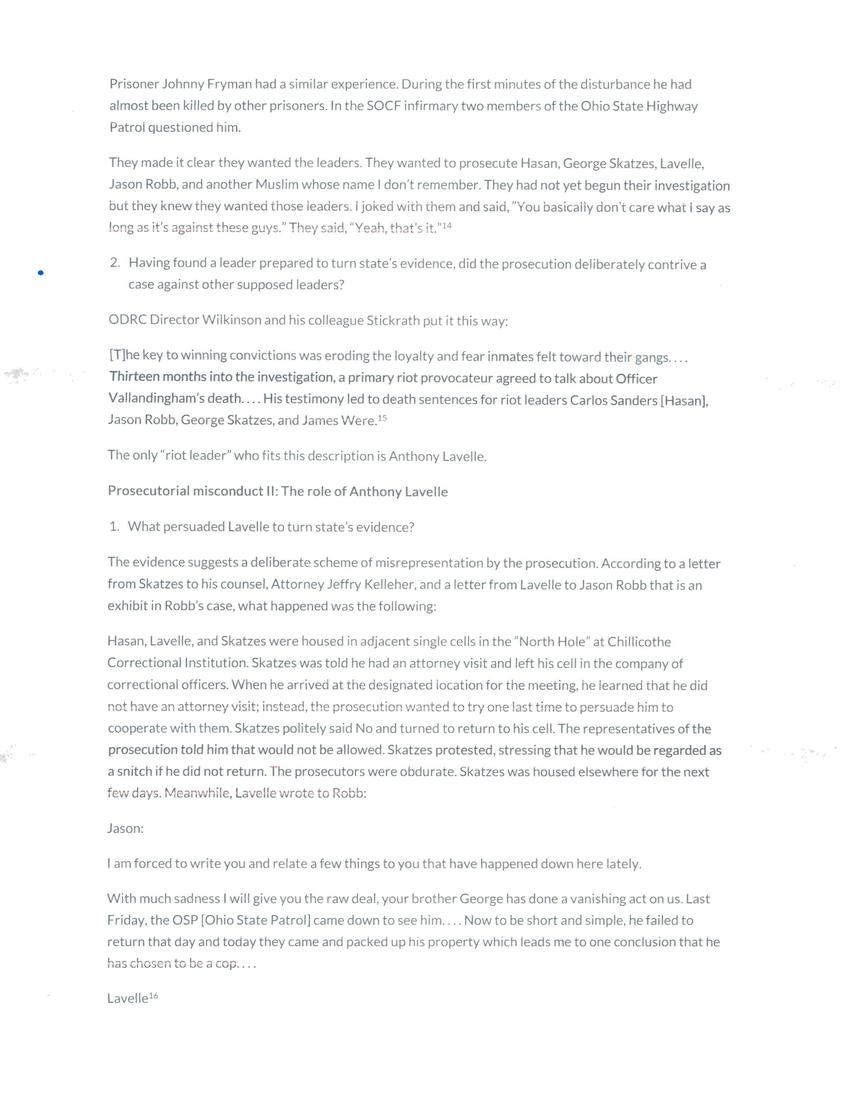
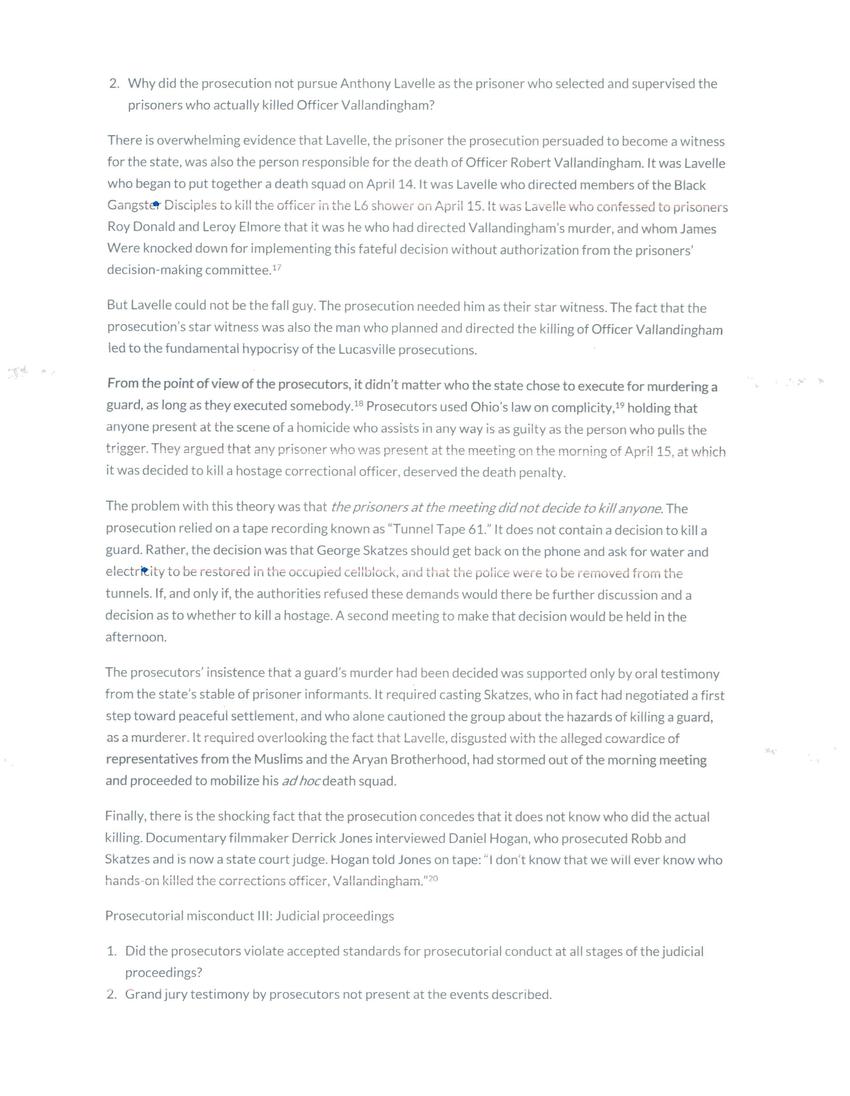
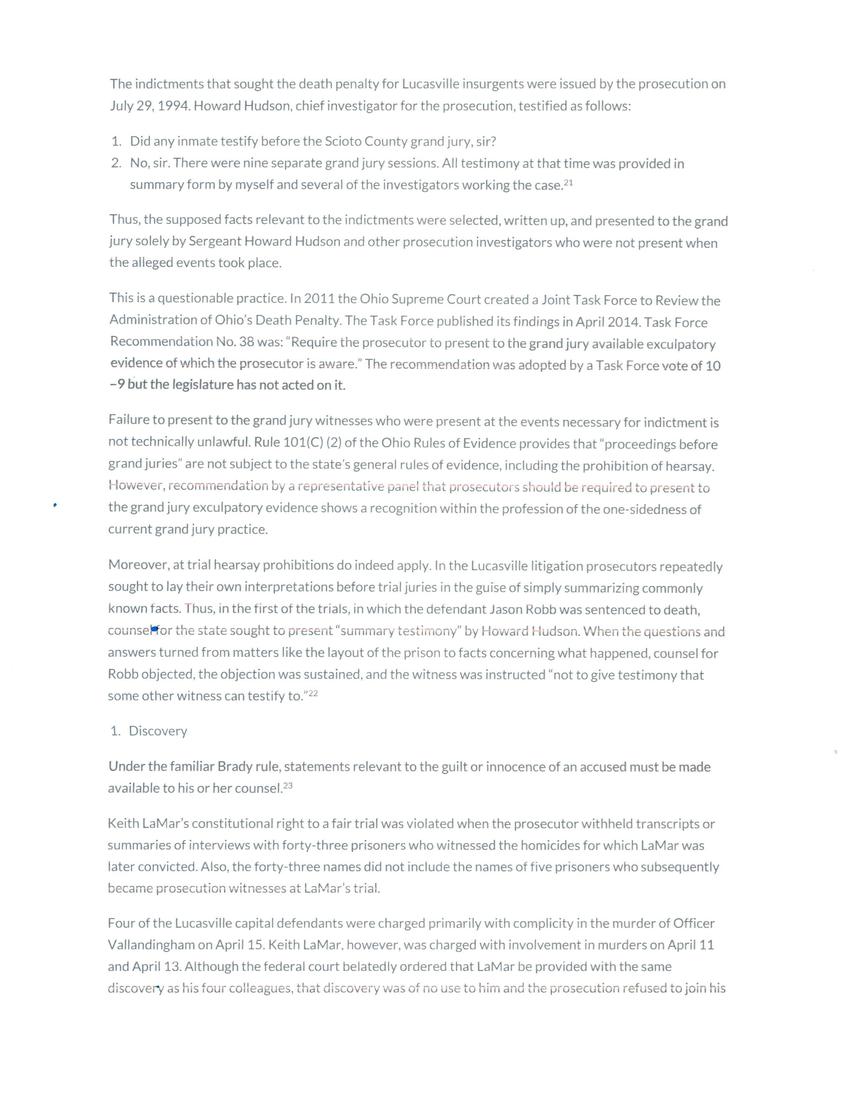
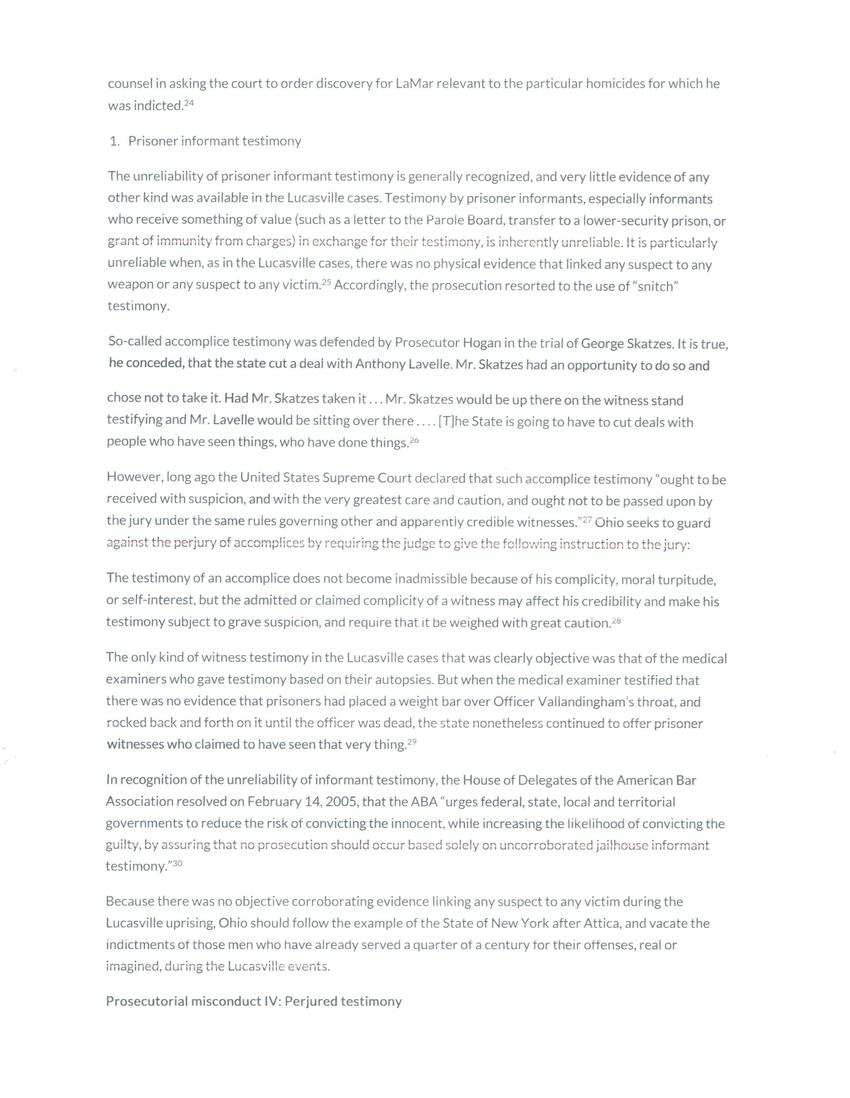
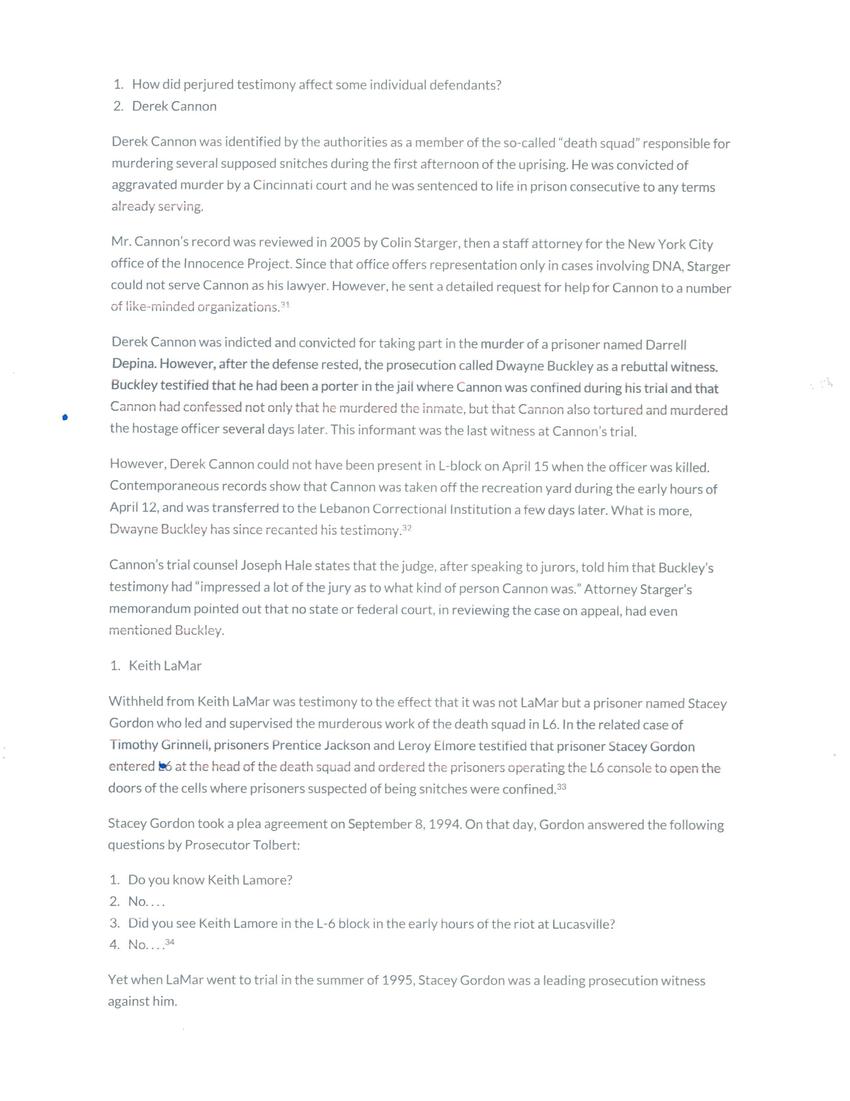
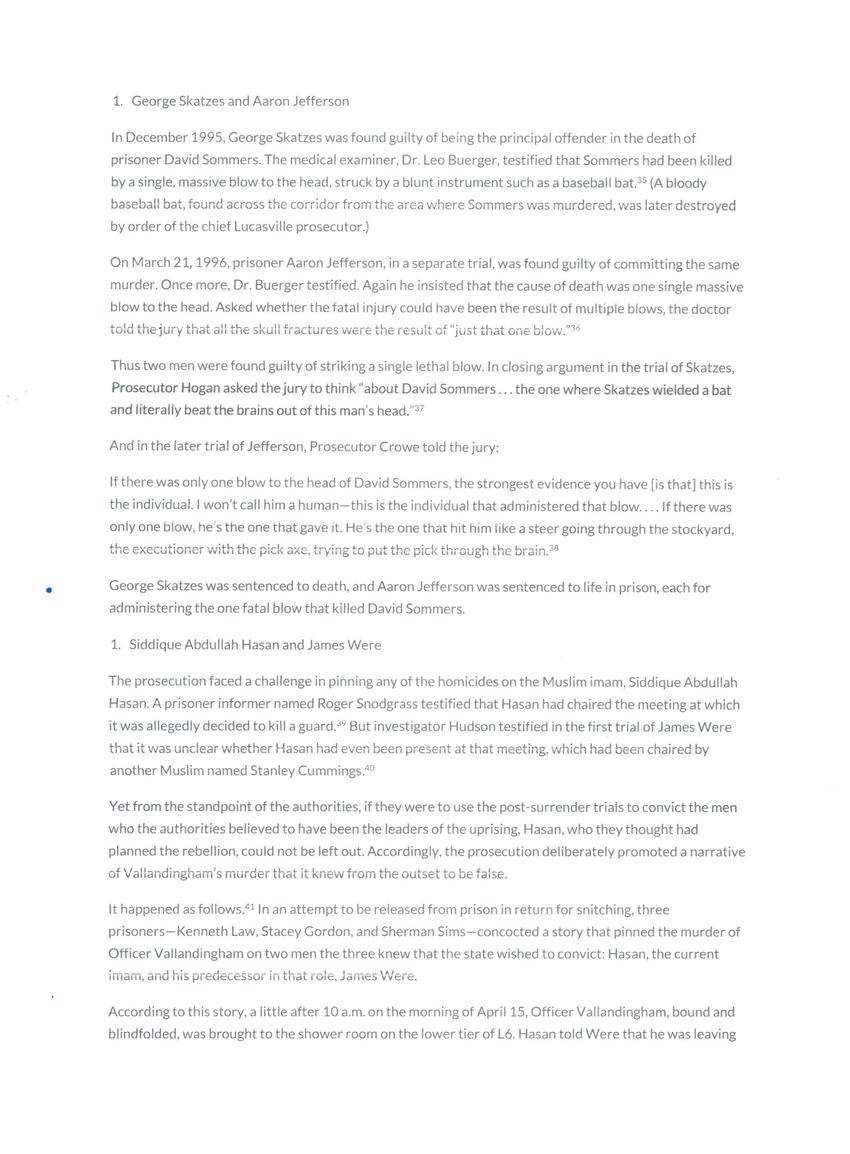
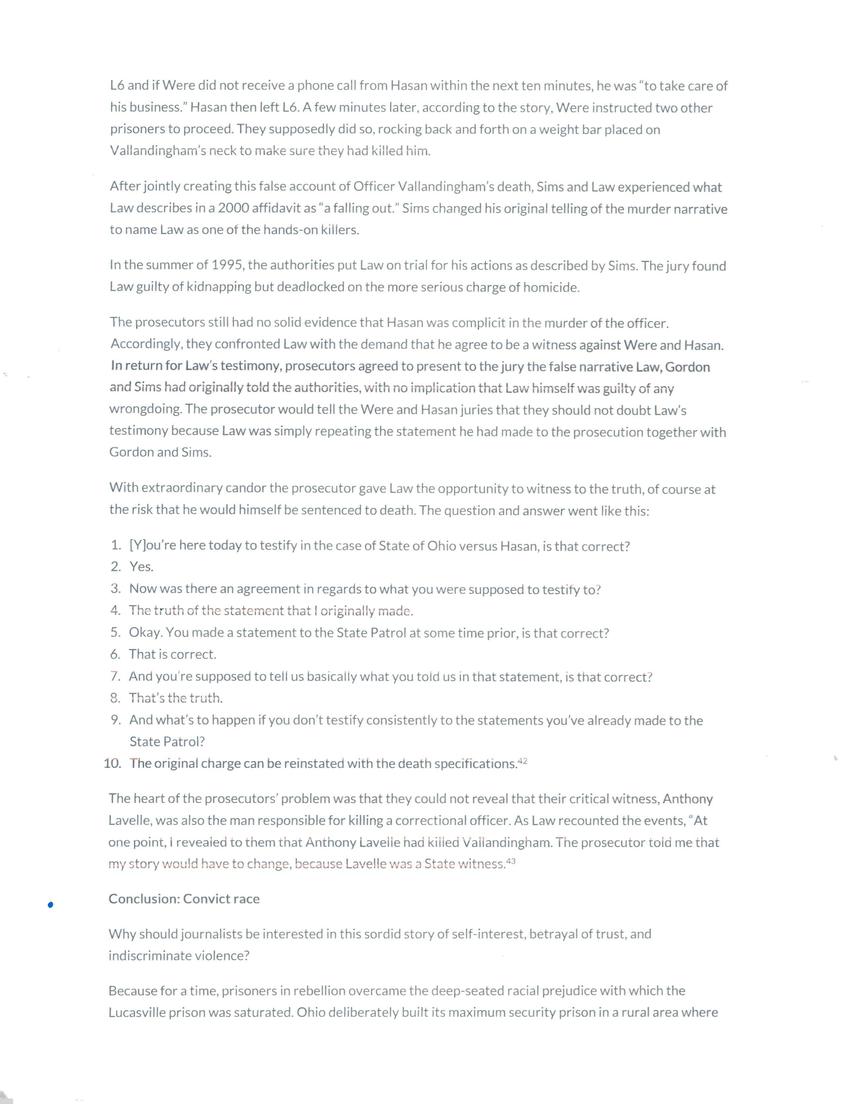
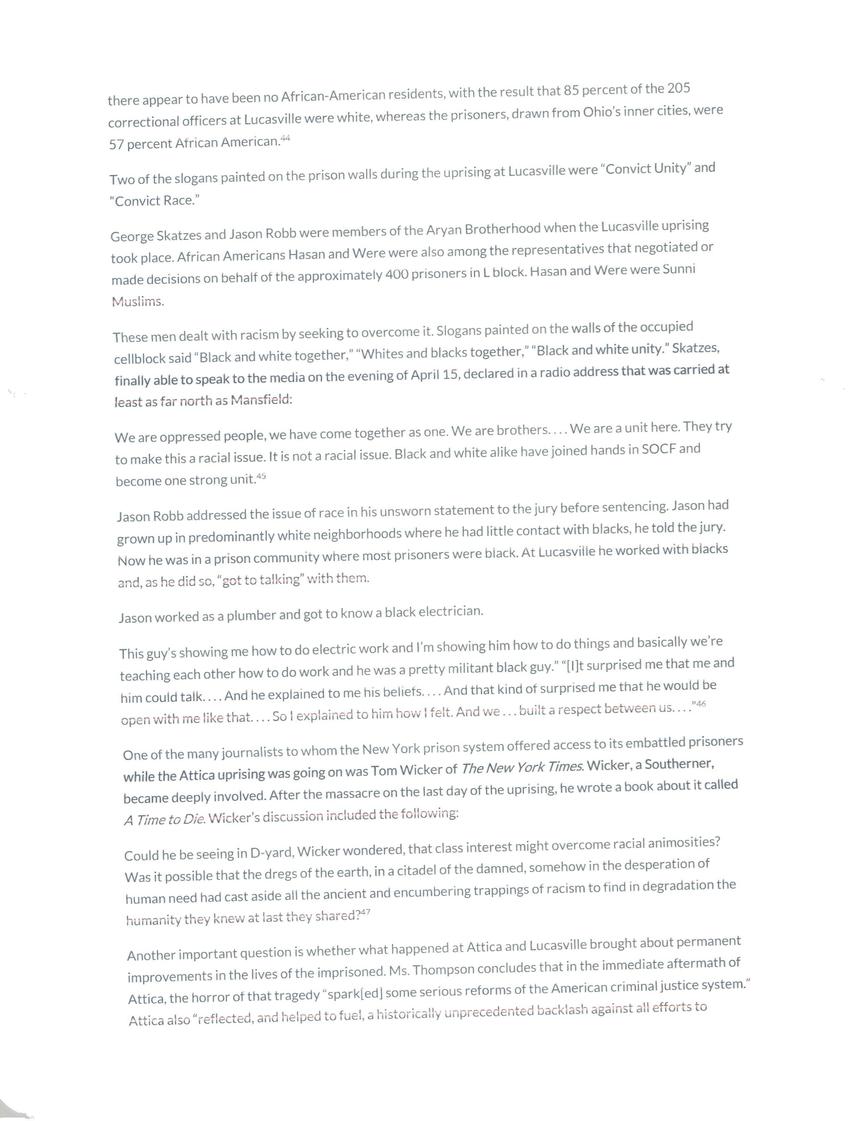
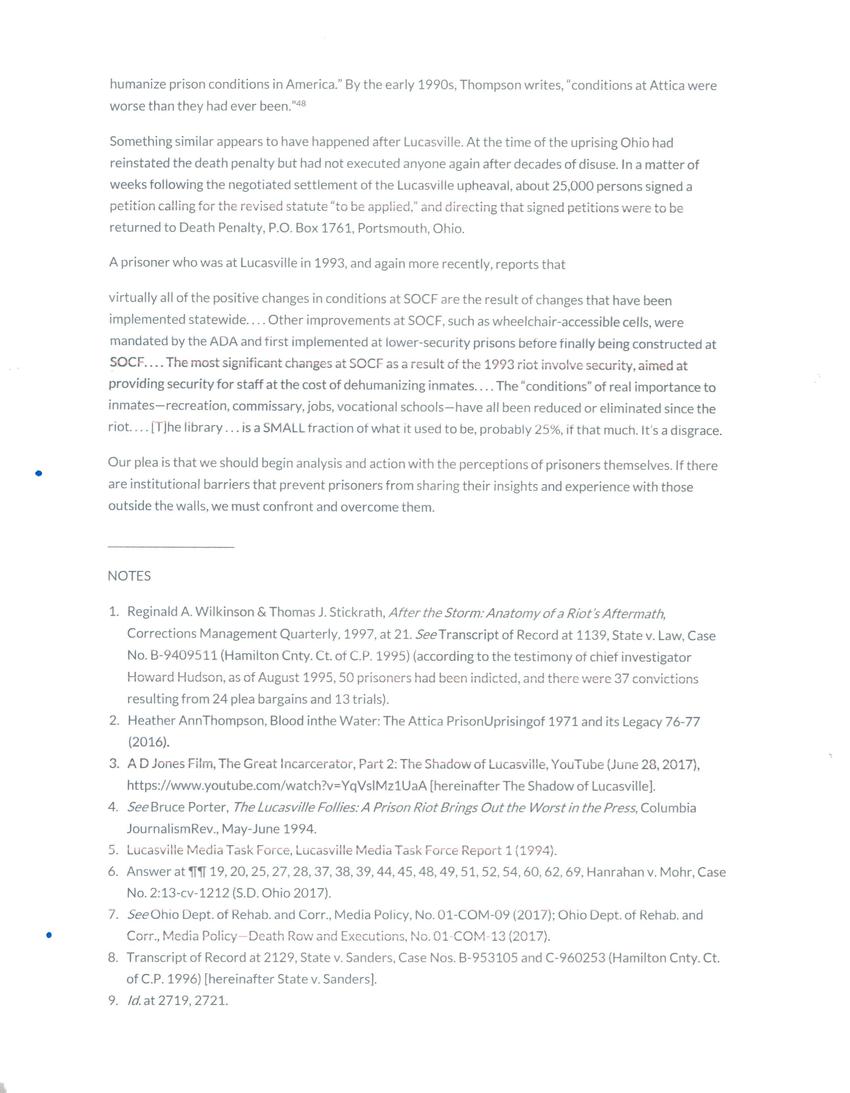
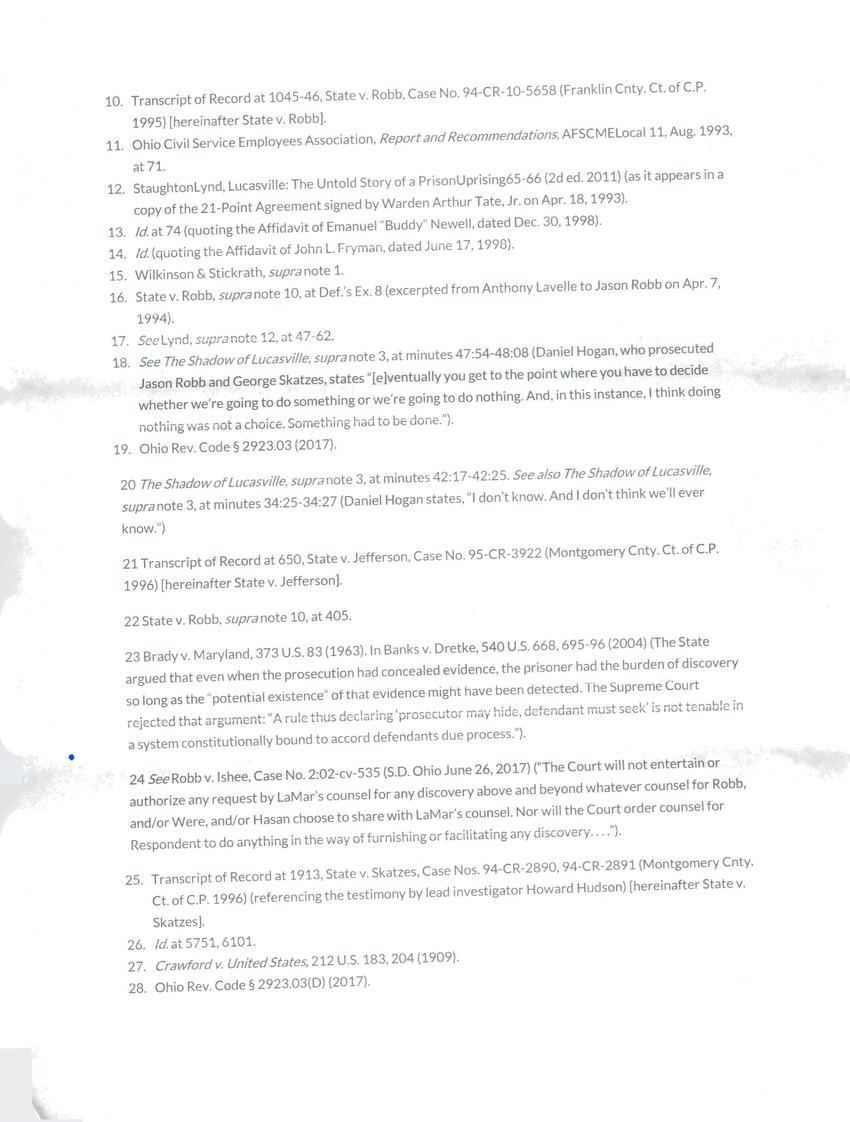
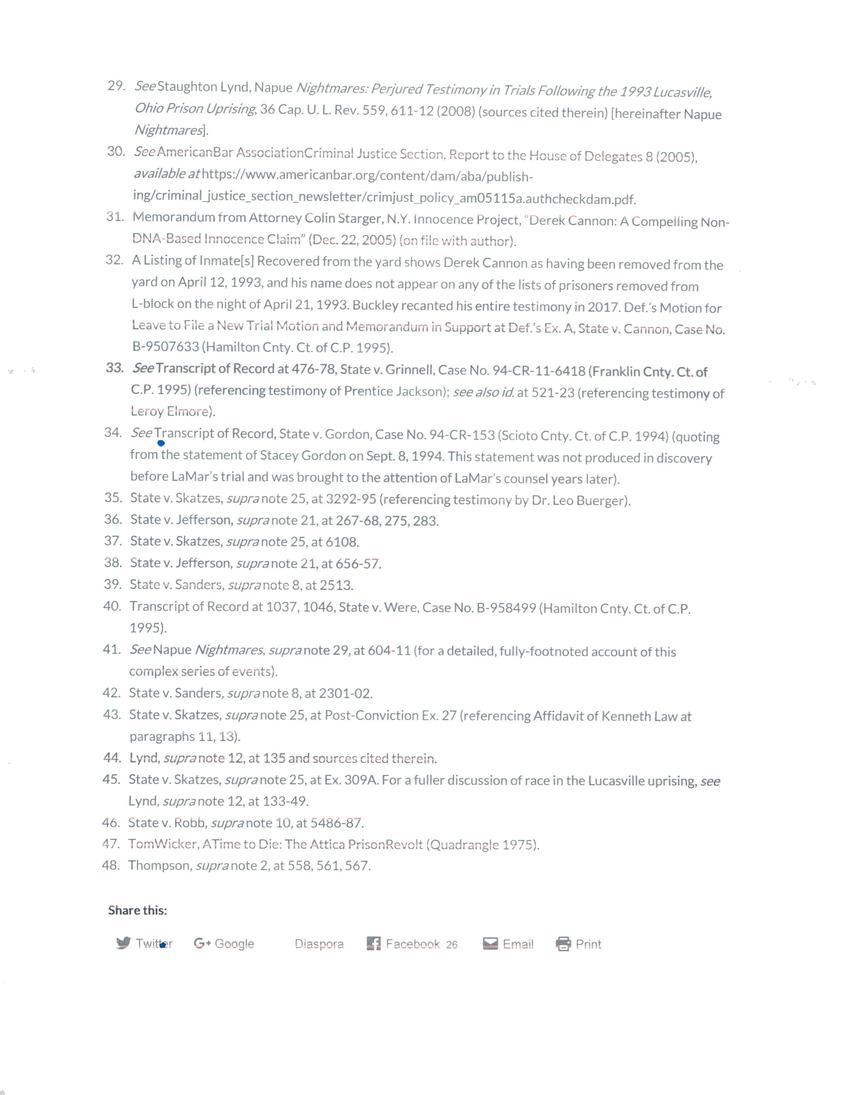

Replies